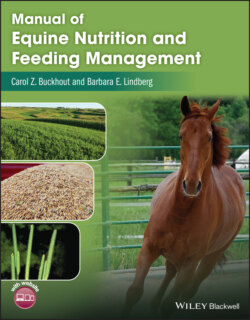Читать книгу Manual of Equine Nutrition and Feeding Management - Carol Z. Buckhout - Страница 2
Table of Contents
Оглавление1 Cover
7 Laboratory 1: THE EQUINE DIGESTIVE SYSTEM Introduction: Objectives: Question for further discussion: General overview: A. Primary organs of digestion: The upper digestive tract B. Primary organs of digestion: The lower digestive tract C. Secondary organs of digestion For additional information: YouTube videos: References:
8 Laboratory 2: PLANT IDENTIFICATION Introduction: Objectives: Questions for further discussion: A. Grasses B. Legumes A. Nuisance plants: these are not poisonous to the horse, but they do not supply proper nutritional value B. Feed and bedding conditions that are harmful to horses C. Poisonous plants: These will cause some sort of external or internal damage to the horse, affecting its health and, in some cases, even causing death For additional information: Helpful websites/links on toxic plants: References:
9 Laboratory 3: FORAGE 1: PASTURE Introduction: Objectives: Questions for further discussion: General overview: Pastures for horses References:
10 Laboratory 4: FORAGE 2: HAY FOR HORSES Introduction: Objectives: Questions for further discussion: Hay For additional information: References:
11 Laboratory 5: CONCENTRATES FOR HORSES Introduction: Objectives: Questions for further discussion: General overview A. Definition B. Characteristics C. Classification D. Processed concentrate feeds E. Feeding grain to horses: suggestions and rules of thumb References:
12 Laboratory 6: (1) BY-PRODUCT FEEDS AND ADDITIVES (2) THE CONCEPTS OF “AS SAMPLED” AND “DRY MATTER” Introduction: Objectives: Questions for further discussion: By-product feeds Feed additives As sampled and dry matter conversions General overview: Examples of calculations between as sampled and dry matter References:
13 Laboratory 7: DETERMINING THE NUTRIENT CONTENT OF FEEDS Introduction: Objectives: Question for further discussion: General overview Practice problems: Calculating the amount of nutrients in feeds Reference:
14 Laboratory 8: THE USE OF FEEDING STANDARDS AND ENGLISH-METRIC CONVERSIONS Introduction: Objectives: Question for further discussion: General overview English/metric conversions:
15 Laboratory 9: RATION EVALUATION PART I Introduction: Objectives: Questions for further discussion: Introduction to Ration Evaluation References:
16 Laboratory 10: RATION EVALUATION PART II Introduction: Objectives: Question for further discussion: Introduction: Utilizing the information on a commercial feed label Example Ration Evaluation Using a Forage Analysis and a Commercial Feed Label: Comments:
17 Laboratory 11: THE PEARSON SQUARE Introduction: Objectives: Questions for further discussion: The Pearson Square Procedure for Calculating the Pearson Square: Important Points to Remember: References:
18 Laboratory 12: CORRECTING NUTRIENT DEFICIENCIES IN A RATION Introduction: Objectives: Questions for further discussion: Correcting Deficiencies: Lack Divided by Gain
19 Laboratory 13: DETERMINING THE COST OF FEEDING Introduction: Objectives: Question for further discussion: General overview: Determining the least cost of two forages based on digestible energy (Lewis, 1996, pp. 140): Determining the least cost of two concentrate mixes based on crude protein: (Lewis, 1996, pp. 140–141) References:
20 INDEX
